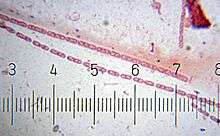Streptobacillus
| Streptobacillus | |
|---|---|
 | |
| Streptobacillus Numbered ticks are 11 µm apart. | |
| Scientific classification | |
| Domain: | Bacteria |
| Phylum: | Fusobacteria |
| Genus: | Streptobacillus |
Streptobacillus is a genus of aerobic, gram-negative facultative anaerobe bacteria, which grow in culture as rods in chains.
Species associated with infection - S. moniliformis
Reported susceptibilities and therapies - penicillin, erythromycin
Diseases
Associated infections: the Haverhill fever form of rat bite fever. (Notes Spirillum minus is also an agent of rat bite fever, in the form known as sodoku.)
Haverhill fever, which is characterized by fever, rash, chills, headache, vomiting, muscle pain, arthritis, and bacteremia, and by weight loss and diarrhea in children.
Commentary
Rat bite fever is caused by either Streptobacillus moniliformis or Spirillum minor. The incidence of rat-bite fever is highest in urban areas with poor sanitation where the rat population is high, however in recent times cases have also been attributed to occupational contact with rodents such as pet shop employees or laboratory workers or through pet ownership.[1]
While the disease is usually caused by a bite, it can also occur from close contact with rodents or ingestion of contaminated food or water. The latter is known as Haverhill fever. The disease typically presents with chills and fever accompanied by headache, vomiting, and muscle pain. A rash and arthritis develop 2–4 days after the initial onset. Less commonly the infection can cause pneumonitis, endocarditis or meningitis. As these symptoms are common to many febrile diseases, this is often classified as a fever of unknown origin (FUO). If untreated, death will occur in approximately 10% of cases.[2]
References
- ↑ Papanicolas, Lito E; Holds, Judith M; Bak, Narin (20 February 2012). "Lessons from practice - Meningitis and pneumonitis caused by pet rodents". The Medical Journal of Australia. 196 (3): 202–203. doi:10.5694/mja11.10841.
- ↑ Elliott, S. P. (11 January 2007). "Rat Bite Fever and Streptobacillus moniliformis". Clinical Microbiology Reviews. 20 (1): 13–22. doi:10.1128/CMR.00016-06. PMC 1797630
 . PMID 17223620.
. PMID 17223620.
- Hagelskjaer L, Sørensen I, Randers E (1998). "Streptobacillus moniliformis infection: 2 cases and a literature review". Scand. J. Infect. Dis. 30 (3): 309–11. doi:10.1080/00365549850161016. PMID 9790145.
External links
- A Web-Surfer's Guide to Bacteria Associated with Infections in Humans
- Streptobacillus moniliformis
- Streptobacillus at the US National Library of Medicine Medical Subject Headings (MeSH)